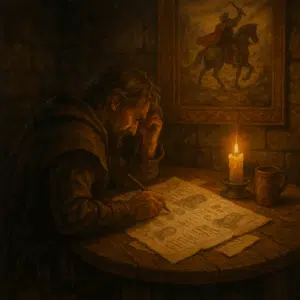Estimated Reading Time: 24 minutes (4510 words)
A great Game Master isn’t born with a twenty-sided die in one hand and a rulebook in the other – they’re forged through countless hours of navigating the delicate space where rules end and magic begins.
Behind every epic campaign that players reminisce about years later stands someone who has mastered the invisible art of orchestration. They’ve learned that the rulebooks are merely a foundation, not a script. This person understands that their true power lies not in knowing every stat block by heart, but in reading the room, adapting on the fly, and creating moments where players forget they’re sitting around a table rolling dice.
The journey to becoming this kind of Game Master isn’t about memorizing more spells or monster abilities. It’s about developing a toolkit of psychological and narrative techniques that transform mechanics into meaningful experiences. It’s knowing when to let the rules fade into the background so the story and player agency can take center stage.
Whether you’re preparing to run your first session or you’ve been behind the GM screen for decades, the techniques that separate functional game runners from memorable experience creators remain surprisingly consistent across systems and styles. These approaches transcend the technical aspects of gaming to address the human elements that ultimately determine whether your campaign fizzles out or becomes the standard against which your players measure all future adventures.
- Behind every memorable tabletop adventure stands a Game Master juggling countless responsibilities. Far more than rule enforcers, great GMs are storytellers, mediators, world-builders, and experience designers who transform rules into unforgettable moments. Mastering this art goes beyond knowing the rulebooks.
- Prepare frameworks, not scripts: The most engaging sessions come from GMs who create flexible foundations rather than rigid plotlines. Build a world that responds to player choices instead of forcing them down predetermined paths.
- Master the art of the meaningful NPC: Create non-player characters with clear motivations, distinct voices, and genuine roles in your world. Players remember the shopkeeper with the mysterious past more than the faceless quest-giver.
- Balance spotlight moments intentionally: Track who’s getting attention during sessions and deliberately create opportunities for quieter players to shine. This conscious distribution of memorable moments keeps everyone invested.
- Embrace “Yes, and” thinking: When players suggest unexpected approaches, resist the urge to block them. Instead, adapt your story to incorporate their creativity while maintaining appropriate challenges and consequences.
- Develop your conflict resolution toolkit: Game-stopping disagreements are inevitable. Having multiple approaches—private conversations, group check-ins, and mid-session adjustments—allows you to address problems without derailing the experience.
- Create emotional landmarks, not information dumps: Players forget elaborate histories but remember how they felt when they saved the village or failed to rescue an ally. Design encounters that evoke specific emotions.
- Build confidence through incremental challenges: Start with familiar scenarios and gradually introduce complexity as your GM skills develop. Each session builds your toolbox for handling increasingly nuanced narrative situations.
The journey to GM mastery is ongoing, even for veterans with decades of experience. The following techniques will help you navigate the delicate balance between preparation and improvisation while creating games your players will talk about for years to come.
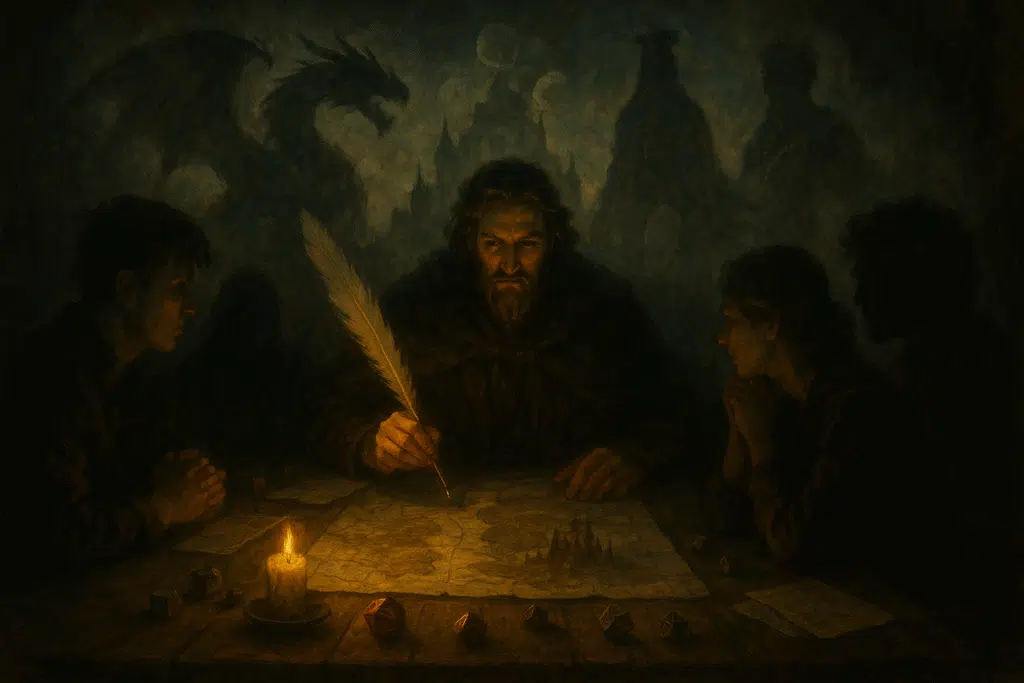
The Dual Nature of Game Mastery
Where rules end and artistry begins
The rulebook sits open on the table, dice arranged in neat formations, and character sheets filled with carefully calculated statistics. Yet the true essence of game mastering exists in the spaces between these tangible elements. Rules provide necessary structure—a common language allowing players to interact with the fictional world consistently. However, a game master who merely administers rules is little more than a processor executing commands. Establishing this foundation of shared understanding begins well before the first session, which is why Session Zero: The Foundation of Meaningful Campaigns creates the psychological framework that allows game masters to transcend mere rule enforcement.
The artistry begins precisely where the rulebook falls silent. When a player asks, “Can I swing from the chandelier, kick the baron in the chest, and grab the mysterious amulet in one motion?”—you won’t find that specific scenario covered in any index. This is where you transition from rule enforcer to possibility weaver. The rules tell you about action economy and difficulty classes, but they don’t capture the dramatic weight of that moment, the collective held breath around the table, or how this action might become the stuff of legend in your campaign.
Moving beyond mechanics to create experiences
Mechanics serve experience, not the other way around. Consider the difference between saying, “You hit the orc for 8 damage” versus “Your blade finds the gap in the orc’s armor; he staggers backward with a roar of pain, his eyes now fixed on you with murderous intent.” Both communicate the same mechanical outcome, but only one creates an experience.
Great game masters develop an intuitive sense for when to emphasize mechanics and when to let them fade into the background. During a tense combat where tactical decisions matter, highlighting specific mechanical elements maintains clarity. During character development or emotional revelations, mechanics should become nearly invisible, allowing the narrative experience to take center stage.
This duality demands constant calibration. You’ll recognize success not by how faithfully you’ve followed the rules, but by the expressions on your players’ faces—the widened eyes, spontaneous cheers, gasps of shock, or thoughtful silences that indicate they’ve momentarily forgotten they’re playing a game at all.
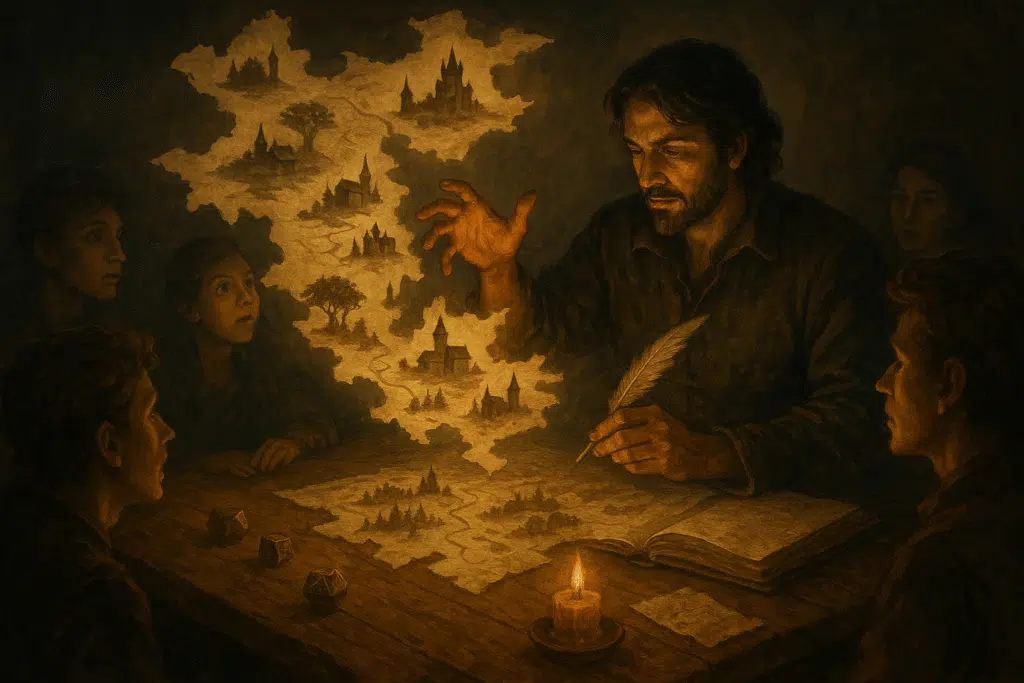
Crafting Flexible Foundations
The framework approach to preparation
The prepared GM’s secret weapon isn’t exhaustive detail—it’s strategic flexibility. Rather than scripting every encounter, conversation, and outcome, craft frameworks that establish essential elements while leaving room for adaptation. Think of preparation as building a skeletal structure that you’ll flesh out during play based on player choices and emerging narrative threads.
A framework approach might include key locations with distinctive features, major NPCs with clear motivations (not scripts), and potential conflict points. When you prepare this way, you spend less time predicting every possible player action and more time understanding your world’s underlying dynamics, allowing you to respond authentically no matter what direction players choose. This flexible framework approach mirrors how skilled storytellers use story mechanics to create meaning rather than rigid plot structures, allowing narrative elements to adapt organically to player choices while maintaining thematic coherence.
Building narrative scaffolding that adapts to players
Effective narrative scaffolding provides just enough structure to support player agency while maintaining meaningful consequences. Consider creating “narrative nodes”—important potential moments or revelations that can occur regardless of the exact path players take. These nodes function as waypoints that can be rearranged, repurposed, or reimagined based on player choices.
If you’ve designed a critical revelation about a villain’s true identity, that revelation doesn’t need to happen in the abandoned tower as initially planned. If players avoid the tower entirely, the revelation can organically emerge during their infiltration of the city sewers instead. The emotional impact remains intact while honoring the players’ chosen path.
Designing problems, not solutions
One of the most liberating preparation techniques is focusing on creating compelling problems rather than predetermined solutions. When you design a sealed ancient vault, resist the temptation to decide exactly how players should open it. Instead, develop the vault’s history, purpose, and defenses—then let players apply their unique abilities and perspectives to overcome the challenge.
This approach not only reduces preparation burden but leads to more satisfying player experiences. When players devise a solution you never anticipated—using an obscure spell combination or leveraging a seemingly inconsequential item from sessions ago—they experience genuine agency. Their characters become competent protagonists rather than participants following a preset script.
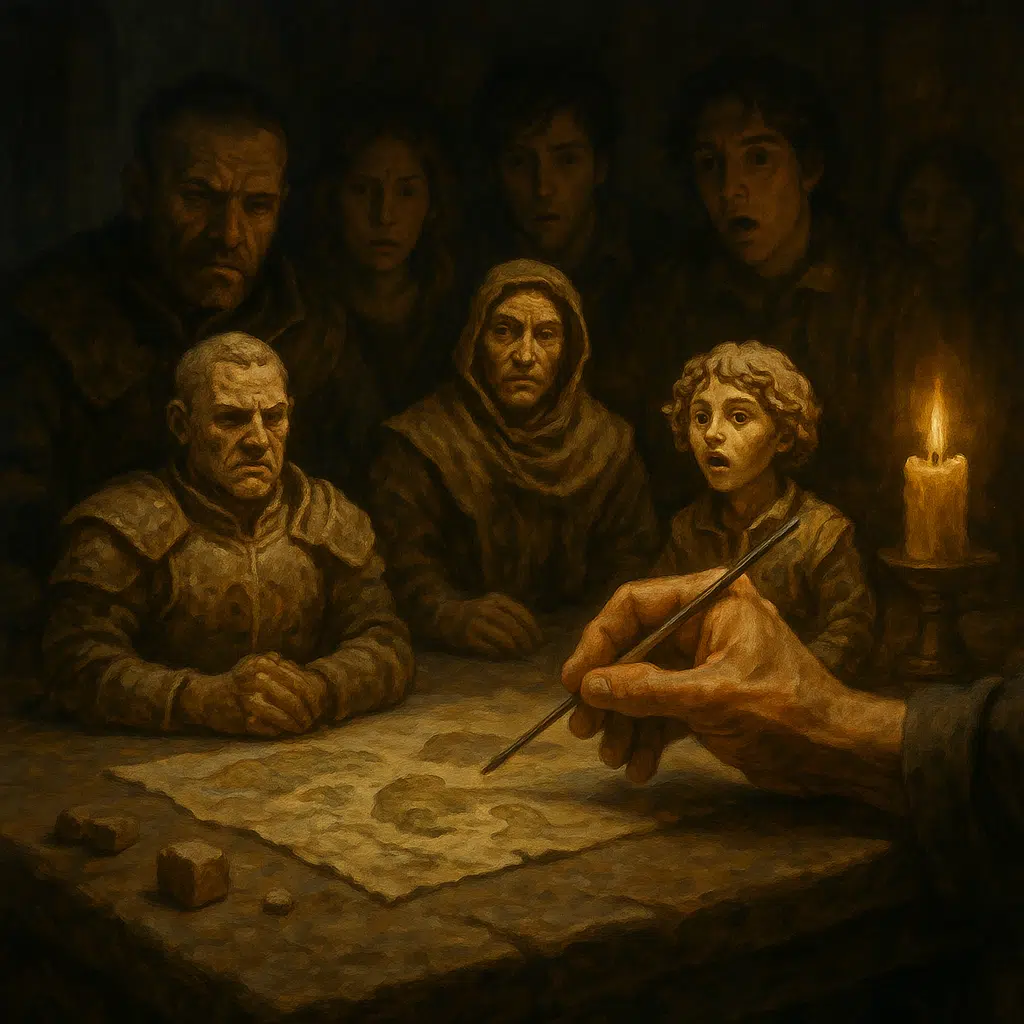
The Living World Beyond Your Players
Creating NPCs with genuine motivations
Non-player characters transform from mechanical obstacles to memorable entities when grounded in authentic motivations. Rather than defining NPCs by their function (“the quest giver” or “the merchant”), define them by what they want and what they fear. A shopkeeper isn’t just someone who sells potions—she’s a former adventurer saving money to buy back her family’s ancestral land, suspicious of strangers after being robbed last season. Developing these authentic motivations requires the same depth of character profiling that drives emotional storytelling, treating NPCs as complete individuals rather than functional game pieces.
Effective NPCs exist at the intersection of desires, constraints, and histories. Even minor characters become compelling when given simple but clear motivations: the guard who’s exhausted from working double shifts, the messenger desperately trying to prove themselves after past failures, the innkeeper who collects exotic stories as payment from travelers who can’t afford gold.
Voice, mannerisms, and making characters memorable
Players rarely remember an NPC’s statistical abilities, but they’ll instantly recall the blacksmith who punctuates every sentence by hammering metal, or the noble who never makes eye contact while speaking. Distinctive vocal patterns, recurring phrases, or physical gestures create immediate recognition and help players form emotional connections to your world’s inhabitants.
You don’t need to be a professional voice actor to create memorable NPCs. Simple adjustments to speaking pace, pitch, or volume can distinguish characters. Physical mannerisms—touching your temple when portraying a thoughtful wizard or sitting especially straight when embodying a disciplined captain—provide visual anchors that help players distinguish between characters during complex interactions.
When NPCs should drive the story (and when they shouldn’t)
The most common NPC pitfall is the dreaded GMPC (Game Master Player Character)—an NPC who steals the spotlight from the actual protagonists. While NPCs should actively pursue their goals within the world, they should rarely drive the central narrative. Their role is to create context, complications, and occasionally clarity for the player characters’ journey.
NPCs function best when they present opportunities, obstacles, or information that propel player decisions. The mysterious sage should provide cryptic knowledge that players must interpret, not solve the mystery herself. The rebel leader should request the party’s help with a dangerous mission, not accomplish it while players watch. When NPCs shine too brightly, they diminish the very role your players gathered to experience.
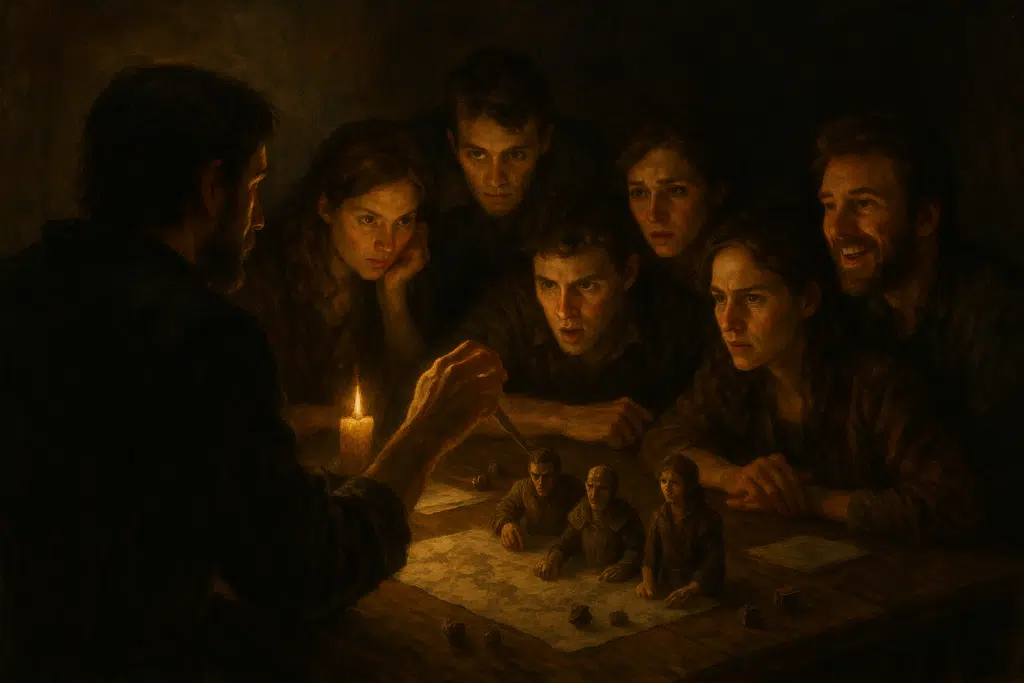
The Psychology of the Gaming Table
Reading the room during crucial moments
Beyond the fictional world lies the very real social dynamic at your table. Developing sensitivity to the emotional current among your players is perhaps the most understated game mastering skill. Watch for subtle cues: the player becoming disengaged, checking their phone more frequently; mounting frustration when a puzzle has stumped the group too long; the undercurrent of tension when one player consistently interrupts another. Creating an environment where players feel comfortable expressing these emotional states requires deliberate attention to psychological safety that enables authentic roleplay, transforming the table into a space where creativity flourishes rather than withers.
Crucial moments like character deaths, major revelations, or narrative turning points demand particular attention. Players may react differently than their characters would—appearing outwardly calm while inwardly distressed or vice versa. Sometimes a quiet check-in (“How’s everyone feeling about this direction?”) provides valuable calibration, while other situations call for reading non-verbal cues to maintain immersion.
Distributing spotlight time intentionally
Every player deserves moments where their character’s unique abilities, background, or perspective becomes central to the unfolding narrative. This spotlight distribution rarely happens organically—it requires deliberate orchestration. Keep track of who’s been central to recent scenes and who might need an opportunity to shine.
Consider creating “character moments” tailored to each player’s preferences. The tactically-minded fighter might thrill at a combat sequence where their positioning expertise saves the party. The relationship-focused bard might shine during a diplomatic negotiation. The detail-oriented wizard might solve an arcane puzzle others overlooked. These moments need not be equal in duration but should be comparable in significance.
Creating space for different player types
Your table likely hosts various player preferences—from the immersive role-player who speaks in character for hours to the strategic thinker who thrives on mechanical challenges to the social player who simply enjoys the collaborative storytelling experience. None of these approaches is superior; they represent different, equally valid ways of engaging with the game.
Create deliberate space for each play style to flourish. Design sessions that include opportunities for deep character interaction, tactical problem-solving, and collaborative worldbuilding. Pay attention to which elements energize each player, and occasionally craft scenarios specifically to engage their preferred mode of play. A campaign that alternates between these different engagement types keeps all players invested and prevents any single approach from dominating the experience.
The Improvisational Mindset
Embracing unexpected player choices
No matter how thoroughly you prepare, players will inevitably make choices you didn’t anticipate. The hallmark of an experienced GM is the ability to respond to these moments not with frustration but with curiosity. When a player suggests something completely unexpected—like negotiating with the dungeon’s “final boss” instead of fighting, or adopting the goblin prisoner you intended as a minor obstacle—consider the narrative possibilities this creates rather than how it disrupts your plans.
Develop the habit of asking “What would realistically happen if they did that?” rather than “How do I get them back to my planned story?” This mental shift transforms potentially frustrating moments into opportunities for the campaign to evolve in organic, collaborative ways that often prove more interesting than what you originally conceived.
The art of “Yes, and” in tabletop roleplaying
Borrowed from improvisational theater, the “Yes, and” principle suggests accepting the premise offered (the “yes”) and then building upon it (the “and”). In gaming terms, this means acknowledging the player’s creative input while maintaining narrative consistency and appropriate challenge.
When a player asks if they can attempt something unusual, like intimidating a guard by creating an illusion of a demon, the “yes, and” approach might sound like: “Yes, you can certainly try that, and given this guard’s superstitious nature, he might be particularly susceptible—though his partner looks more skeptical.” This validates the player’s creativity while maintaining realistic consequences and preserving tension.
Maintaining challenge while honoring creativity
Creative solutions should be rewarded without eliminating meaningful challenge. When players devise an approach that cleverly circumvents an obstacle, resist the temptation to nullify their strategy (“The lock is magically immune to your acid”). Instead, honor their ingenuity while introducing proportional complications (“The acid dissolves the lock successfully, but the sizzling sound has alerted the nearby guards”).
This balancing act requires constant calibration. Solutions that leverage character abilities, established world elements, or thoughtful planning should generally succeed—with the degree of success and accompanying complications scaled to maintain narrative tension. This approach encourages continued creativity while preserving the satisfaction that comes from overcoming meaningful obstacles.
When Things Go Sideways
Navigating disagreements without derailing the game
Rule interpretations, character motivations, and narrative developments will occasionally spark disagreements at your table. How you handle these moments often determines whether they become brief speedbumps or session-destroying roadblocks. The key principle is containment—addressing the issue efficiently without allowing it to consume the experience.
For rules disagreements, consider implementing a “quick resolution policy”: make a provisional ruling to keep the game moving, note the question for detailed research after the session, and apply consistent rulings going forward. This approach respects the importance of rules clarity while prioritizing session momentum and player engagement.
Conversation techniques for different personality types
Different players respond to different conversation approaches during moments of tension. The analytical player needs logical explanation and precedent. The emotionally invested player needs acknowledgment of their frustration before any problem-solving can occur. The conflict-avoidant player may remain silent despite their discomfort, requiring proactive but gentle check-ins.
Develop a repertoire of phrases that de-escalate without dismissing: “I understand why that ruling feels inconsistent with what happened before; let’s handle it this way for now and I’ll make sure we have clarity for next time.” Or, “I can see you’re really invested in this outcome, which speaks to how much you care about your character’s story—that’s awesome. Here’s how we might find middle ground…”
Adjusting mid-session without breaking immersion
Sometimes a planned encounter proves too difficult, a narrative thread falls flat, or the session’s energy noticeably dissipates. The skilled GM makes mid-course corrections without drawing attention to the adjustment. If an overpowered enemy is decimating the party beyond what creates good tension, they might suddenly need to “secure another area,” allowing a more manageable fight. If players seem disengaged with a political intrigue sequence, an unexpected event can transition to action.
Make these adjustments without commentary—nothing breaks immersion faster than meta-explanations like “This seems too hard so I’m making it easier.” The goal is maintaining the fiction that everything unfolds according to the world’s internal logic, even when you’re actually responding to the social and emotional needs of your players.

Emotional Architecture in Campaign Design
Crafting moments players will remember for years
The campaigns that linger in players’ memories for years are built around emotional landmarks—moments of revelation, sacrifice, triumph, or heartbreak that transcend mechanical gameplay. These moments rarely emerge from complex rule interactions; they come from situations that engage players’ emotions through character investment and meaningful choices. The type of emotional landmarks you create often depends on your campaign’s genre foundation, as different fantasy approaches naturally generate distinct emotional experiences and player expectations that shape how these memorable moments unfold.
Design potential emotional landmarks by creating scenarios with personal stakes for the characters. The enemy isn’t just a stat block; she’s the mentor who betrayed the wizard’s trust years ago. The ancient artifact isn’t just a +2 sword; it’s the symbolic legacy of the paladin’s fallen order. When mechanics and emotional significance align, players experience moments of genuine investment that become campaign-defining memories.
Beyond information: creating emotional landmarks
Information-driven storytelling (“You discover the cult is planning to summon the demon on the solstice”) engages players intellectually but rarely creates memorable moments. Emotional storytelling transforms information into experiences that resonate on a deeper level (“As you decipher the cult’s plans, you recognize the handwriting—it belongs to your brother who disappeared last winter”).
Create emotional resonance by connecting narrative developments to character backgrounds, previous choices, and established relationships. When revelations have personal implications beyond tactical considerations, players experience the story on both intellectual and emotional levels. These layered moments become reference points that players will recall years later—”Remember when we found out Jormund was working with the cult all along?”
The power of consequential decision points
The most powerful moments in roleplaying games often center on difficult choices with no obviously correct answer. Design decision points where multiple options have legitimate appeal and meaningful consequences. These aren’t “trick choices” with a single good option, but genuine dilemmas that reflect the complex values and priorities of the characters.
True consequential choices force players to prioritize competing values: Do they save the innocent villagers or pursue the villain who might escape? Do they maintain their moral code or compromise for a greater good? Do they honor their character’s personal desires or sacrifice for the group? When these decisions shape the campaign’s direction in visible ways, players experience true agency—their choices matter because they could genuinely have chosen differently.
Growing Your GM Confidence
Starting with familiar territory
New game masters often feel pressure to create entirely original campaigns with innovative mechanics in unfamiliar systems. This perfectionism frequently leads to paralysis or burnout. Instead, begin with what you know: run a pre-written adventure in a system you’ve played before, or set your story in a fictional world you deeply understand from books, games, or films.
Familiar territory provides a foundation of confidence while you develop the specific skills of game mastery. When you already understand the basic setting or system, you can focus your creative energy on bringing characters to life, managing pacing, and responding to player choices—the core competencies that distinguish great game masters regardless of the specific game being played.
Incremental challenge expansion
Develop your GM abilities by intentionally adding one new challenge or technique at a time. If you’re comfortable with rules management and basic narration, perhaps add the challenge of playing distinct NPCs with different speech patterns. Once that becomes natural, experiment with more complex narrative structures or environmental storytelling techniques.
This incremental approach prevents overwhelm while steadily expanding your capabilities. Track your progress by identifying specific skills you’re developing rather than making vague assessments of entire sessions. Rather than thinking “That session didn’t go well,” recognize specific elements: “My combat narration is improving, but I need to work on making political intrigue engaging.”
Learning from both successes and failures
Every GM experiences sessions that soar and sessions that stumble. Both contain valuable lessons when approached with curiosity rather than judgment. After particularly successful moments, ask yourself: What specific elements made this work? Was it the pacing, the personal stakes, the player agency, the vivid description? How can I recreate these conditions intentionally?
Similarly, examine difficult sessions as data rather than failures. If players seemed disengaged during a particular sequence, what might have caused this? Did the scene run too long? Were the stakes unclear? Did one player dominate the interaction? This analytical approach transforms disappointing experiences into growth opportunities without undermining your confidence.
The Invisible Toolkit
Pacing techniques for maintaining energy
Energy at the gaming table naturally ebbs and flows, but skilled GMs develop techniques to maintain momentum through deliberate pacing choices. Recognize when to compress time (“After three days of uneventful travel, you arrive at the mountain pass”) and when to expand it (“Let’s slow down and play through this conversation moment by moment, as it seems important to your character’s development”).
Use time pressure selectively to create urgency: countdowns, approaching threats, or limited resources. These constraints focus player attention and accelerate decision-making. Conversely, explicitly signal moments where players can breathe and take their time: “You’ve secured the chamber and have about an hour before the patrol returns. What would you like to do in this space?”
Transitioning between scenes effectively
The space between scenes often determines whether your session feels cohesive or disjointed. Develop clear transition techniques that signal scene changes while maintaining narrative flow. These might include sensory resets (“The humid jungle air gives way to the cool stone corridors of the temple”), temporal bridges (“As the sun sets on your conversation with the elders, the next morning brings…”), or thematic connections (“From one difficult choice to another, we now find Kestra facing…”).
Avoid transitions that break immersion with mechanical language (“Let’s switch scenes now” or “Meanwhile, back at the castle…”). Instead, make transitions feel like natural extensions of the narrative flow, maintaining the impression of a continuous, cohesive world even as you direct attention to different locations or characters.
When to zoom in and when to montage
The narrative camera of your campaign can zoom in for intimate, detailed role-playing or pull back for montage sequences that cover greater time or distance. Neither approach is inherently better—the art lies in knowing when each serves the story and player experience.
Zoom in when: moments have emotional significance, important information is being discovered, players are making consequential choices, or character relationships are developing. These close-focus scenes reward detailed attention and benefit from methodical pacing.
Use montage when: activities are routine or established, outcomes are predetermined but worth acknowledging, or you need to cover significant time or distance without losing momentum. Effective montages maintain player agency through selective detail and occasional choice points while avoiding the tedium of playing through predictable sequences.
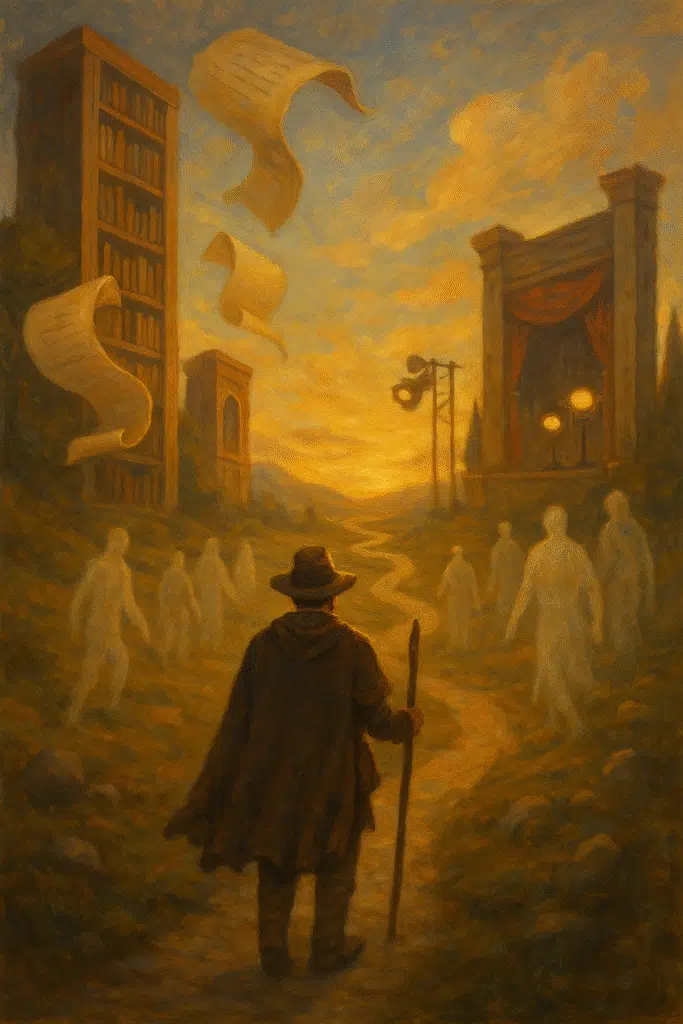
The Ongoing Journey of Mastery
Learning from other storytelling mediums
Game mastery benefits enormously from cross-pollination with other storytelling forms. Study how film directors use visual framing to direct attention and create mood—then apply those principles to your scene descriptions. Analyze how novelists develop character through small, revealing details rather than exposition—then use similar techniques for your NPCs. Notice how playwrights create subtext through what remains unsaid—then incorporate meaningful silences and implications in your dialogues.
These adjacent storytelling forms offer specialized insights that can be translated to the tabletop environment. Television teaches episode structure and cliffhanger construction. Improvisational theater demonstrates character development through interaction. Even video game design offers lessons in creating meaningful choices and rewards. Regular exposure to diverse storytelling mediums continuously refreshes your creative toolkit.
Finding your unique GM voice
The most memorable GMs aren’t those who perfectly imitate others’ styles—they’re those who develop distinctive approaches that reflect their unique strengths and interests. Some game masters excel at tactical combat with rich environmental descriptions. Others create emotionally complex characters that feel like real people with goals and flaws. Still others construct intricate mysteries or political intrigues that unfold over months of play.
Identify elements that energize you as a GM and lean into those strengths while finding systems to support areas that come less naturally. If detailed battle maps drain your enthusiasm, consider theater-of-the-mind combat supplemented with simple position tracking. If voice acting feels uncomfortable, focus on describing characters’ body language and actions rather than performing different voices.
Balancing tradition with innovation
The tabletop roleplaying hobby carries rich traditions worth preserving—collaborative storytelling, shared imagination, face-to-face social interaction—alongside opportunities for continuous innovation. The masterful GM honors what makes this medium special while thoughtfully incorporating new techniques, technologies, and perspectives that enhance the core experience.
Consider how digital tools might supplement rather than replace traditional elements: using ambient soundscapes while maintaining physical dice rolling, incorporating digital character sheets while preserving around-the-table interaction. Evaluate new narrative techniques or safety tools based on how they serve your specific group’s needs rather than adopting every trend uncritically.
This balance requires ongoing reflection about what truly enhances your table’s experience versus what might dilute the essential qualities that make tabletop roleplaying uniquely valuable. The goal isn’t preserving tradition for its own sake nor changing for change’s sake, but thoughtfully evolving your practice to create the most engaging, inclusive, and meaningful experiences possible for your specific players.
The dice will fall where they may, but the memories you craft together transcend any roll of chance. Behind every triumphant victory and heartbreaking defeat lies not just your preparation or improvisation, but your willingness to breathe life into a shared imagination. As you continue developing your GM craft, remember that the greatest campaigns aren’t measured by perfect rule implementation or flawless narrative arcs, but by those electric moments when everyone at the table leans forward, completely present in a world that exists nowhere else but in the space between you all.



